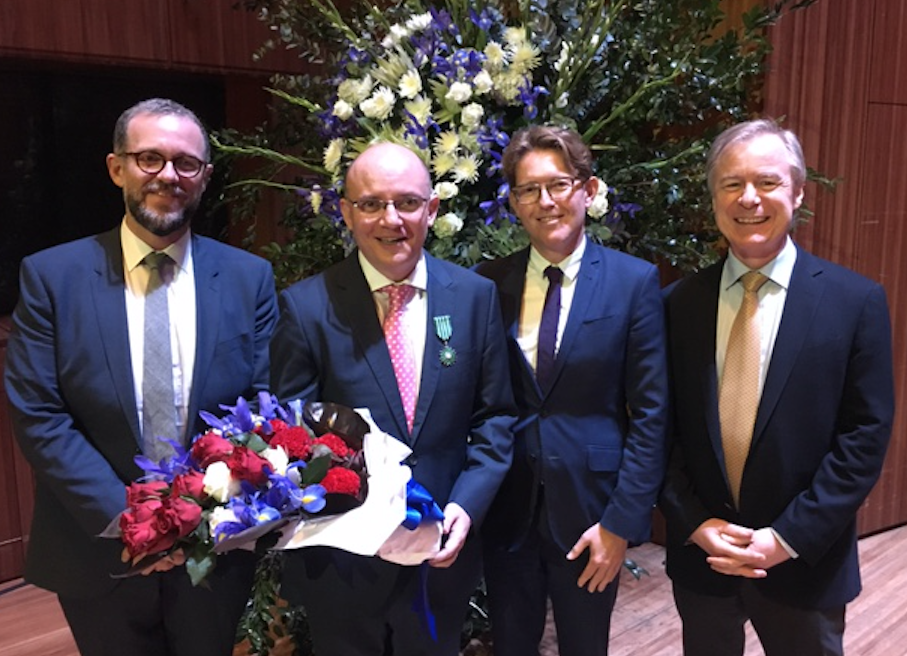British-Australian organist Joseph Nolan is Master of Music at St. George’s Cathedral in Perth, but Sydneysiders and organ aficionados would more likely know him for his celebrated series of Widor’s Organ Symphonies on the Signum label. Either way, there was a bit of a buzz in the air for his Sydney Symphony Orchestra recital as evidenced by a packed SOH Concert Hall – at 11am on a Friday morning! – and the opportunity to hear him take on two of the repertoire’s more fearsome beasts: Liszt’s mighty Fantasy and Fugue on Ad Nos, Ad Salutem and Widor’s Fifth (the one with that Toccata).
The Liszt first, and the longest of the great Romantic virtuoso’s essays for organ. Combining the composer’s twin (and occasionally conflicting) passions – church and the theatre – the Fantasy and Fugue may seem a work of intense and magisterial religiosity, but it’s Latin-monickered theme is actually taken from Meyerbeer’s then current operatic hit, Le Prophète. Liszt couldn’t resist a good tune and was an old hand at spinning out a catchy ditty into an ear-tickling fantasia, but in this case he really did excel himself, producing a multifaceted work of colour, subtlety and power.
Nolan tackled the work head on, his muscular approach paying dividends in the grand, tonally ambitious opening. Not to dumb matters down, but this is classic ‘Phantom of the Opera’ fare, full of scrunchy chords and diminished intervals – an homage to the Gothic rivaling Meyerbeer’s own in his highly melodramatic opera. Although on view from the rear only, Nolan’s arms and legs visibly entered into the impassioned spirit of the piece, some neat passages where Liszt writes pedal solos allowing the octopus-like organist space to rapidly adjust his stops.
Although virtuosity would become less and less important to Liszt as he grew older, in 1850 he still retained something of the enfant terrible, and Nolan proved more than up to the demands placed on manual dexterity. But Liszt also allows for some lovely lyrical explorations of the malleable theme, and one of the beauties of his reading was the effortless way Nolan slipped from one mood into the other. Equally impressive was an impeccable balance between the long melodic lines assigned to one hand, the fiendish figurations in the other, and the sonorous pedal notes running beneath it all.
Other pleasures included the cheeky ‘Hollywood’ fanfares, the jaunty approach opening the mighty double fugue, and at one point a pair of dancing feet to rival Fred Astaire. As an exercise in complementing contrapuntal complexity with spiritual simplicity, Nolan’s interpretation was the real deal. The Widor may have been the drawcard here, but it was the gripping urgency of his Liszt that maybe had the power to linger longer.
Not that there was anything shabby about the Widor. Nolan’s credentials are first-class and his deserved reputation was on display throughout the five-movement organ symphony – the French composer’s most popular, thanks to wedding couples across the globe exiting churches to its grand finale. But the work is more than simple flash and dash, and perhaps the most enjoyable aspect of Nolan’s reading was his sure-footed dramatic pacing and ability to tease colours out of the less showy movements.
A natural sense of the music’s ebb and flow pervaded the opening Allegro vivace, with tasteful rubato and even a playfulness at times. The lyrical, delicate Allegro cantabile was trippingly delivered, the melody again perfectly balanced against the figured accompaniment. The Andantino quasi allegretto is perhaps the trickiest movement to get right. Nolan sorted himself from the boys here with an instinctual grasp of Widor’s dramatic through line and a sure-footed poise in the complicated cross rhythms required between hands and feet. A sensitive take on the gentle Adagio led into the barnstorming Toccata, a crisply articulated reading that drew sufficient cheers to be immediately repeated with some smartly conceived dynamic variations.
 Joseph Nolan with SSO Chief Conductor David Robertson, Nicolas Crozier (Consul General of France) and Philippe Platel (Cultural Attaché)
Joseph Nolan with SSO Chief Conductor David Robertson, Nicolas Crozier (Consul General of France) and Philippe Platel (Cultural Attaché)
French organ repertoire and Nolan have gone hand in hand for many years, ever since his studies in Paris with the great Marie-Claire Alain. It was a special bonus to the programme, then, to have Sydney Symphony Orchestra Chief Conductor David Robertson – noticably fired up by Nolan’s “extraordinary performance” – introduce the French Consul to present the organist with France’s prestigious medal of a Chevalier (Knight) in the Ordre des Arts et des Lettres. Noting that the concert had taken place in a room designed to resemble an organ, and inside the Sydney Opera House – “symbol of a modern Australia” – M. Crozier commended Nolan for his “passion for French music”, his 11 CDs and his “special commitment to Widor”.
Citing Fauré’s maxim that “art and music especially consists of raising ourselves as high as possible above that which is”, and speaking in French – “otherwise it will not count” – Crozier duly ‘ennobled’ Nolan with a “Bravo!” and the traditional kiss on both cheeks.











Comments
Log in to join the conversation.